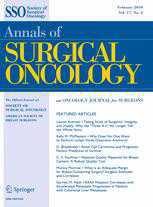Ann Surg Oncol:直肠癌术前放(化)疗可损伤患者肛肠功能
2013-01-09 Ann Surg Oncol. dxy ecoliDh5
术前放(化)疗(pR(C)T)可显著降低患者局部复发风险,因而被推荐用于II/II期直肠癌患者。然而,这类多模式治疗方法可能与后期不良事件存在关联。为了确定pR(C)T对肛肠功能、性功能以及排尿功能的长期影响,德国慕尼黑工业大学的Martin Loos博士等人进行了一项系统性考察与荟萃分析。该文发表于2012年12月27日在线出版的《外科肿瘤学年鉴》(An

术前放(化)疗(pR(C)T)可显著降低患者局部复发风险,因而被推荐用于II/II期直肠癌患者。然而,这类多模式治疗方法可能与后期不良事件存在关联。为了确定pR(C)T对肛肠功能、性功能以及排尿功能的长期影响,德国慕尼黑工业大学的Martin Loos博士等人进行了一项系统性考察与荟萃分析。该文发表于2012年12月27日在线出版的《外科肿瘤学年鉴》(Annals of Surgical Oncology)杂志上。
研究人员通过PubMed、Embase以及Cochrane图书馆,系统性搜索了对接受术前放(化)疗及直肠癌切除术后,患者长期机体功能预后方面进行报道的相关研究文献。该研究合格入选研究类型为,针对通过TME(全直肠系膜切除术)技术结合直肠癌切除术前放(化)疗后,在患者肛肠功能、性功能以及/或排尿功能方面进行报道的相关研究文献。
研究人员最终共甄别出25项研究,涉及6,548例患者。他们发现,合格研究的方法学质量较低。大多数研究报道称,术前放(化)疗后,患者肛肠功能(14/18项研究)以及男性患者的性功能(9/10项研究)出现障碍。少数研究对女性患者的性功能障碍情况进行了考察(n = 4)。荟萃分析表明,放疗患者更易出现大便失禁情况(风险比 (RR) = 1.67; 95 %置信区间(CI), 1.36, 2.05; p<0.0001),此外,术前放(化)疗后,患者的测压结果 (平均静息压力(加权平均差(WMD) = 15.04; 95 % CI, 0.77, 29.31; p = 0.04)以及最大收缩压力结果(WMD = 30.39; 95 % CI, 21.48, 39.3; p<0.0001))明显较差。荟萃分析也表明,在患者勃起障碍方面并不存在统计学意义上的显著性差异(RR = 1.41; 95 % CI, 0.74, 2.72; p = 0.3)。8项研究中的6项研究,以及荟萃分析都表明,术前放(化)疗对患者排尿功能无副作用(RR = 1.05; 95 % CI, 0.67, 1.65; p = 0.82)。
Martin Loos博士等人据此认为,尽管患者功能长期预后方面研究的质量较为有限,但现有证据足以证明,术前放(化)疗后进行TME可对患者肛肠功能产生负面影响。

Background
Preoperative radio(chemo)therapy (pR(C)T) significantly reduces the local recurrence risk and is therefore recommended in stage II/III rectal cancer. However, this multimodal treatment approach may be associated with late adverse effects. To determine the impact of pR(C)T on long-term anorectal, sexual, and urinary function, we performed a systematic review and meta-analysis.
Methods
PubMed, Embase, and the Cochrane Library were systematically searched for studies reporting on long-term functional outcome after rectal cancer resection with pR(C)T. Only studies that reported anorectal, sexual, and/or urinary function after rectal cancer resection in TME-technique with pR(C)T were eligible for inclusion.
Results
Twenty-five studies, including 6,548 patients, were identified. Methodological quality of the eligible studies was low. The majority of studies reported higher rates of anorectal (14/18 studies) and male sexual dysfunction (9/10 studies) after pR(C)T. Few studies examined female sexual dysfunction (n = 4). Meta-analysis revealed that stool incontinence occurred more often in irradiated patients (risk ratio (RR) = 1.67; 95 % confidence interval (CI), 1.36, 2.05; p < 0.0001) and manometric results were significantly worse after pR(C)T (mean resting pressures (weighted mean difference (WMD) = 15.04; 95 % CI, 0.77, 29.31; p = 0.04) and maximum squeeze pressures (WMD = 30.39; 95 % CI, 21.48, 39.3; p < 0.0001)). Meta-analysis of erectile dysfunction revealed no statistical significance (RR = 1.41; 95 % CI, 0.74, 2.72; p = 0.3). Six of eight studies and meta-analysis demonstrated no negative effect of pR(C)T on urinary function (RR = 1.05; 95 % CI, 0.67, 1.65;p = 0.82).
Conclusions
Although quality of studies on long-term functional outcome is limited, current evidence demonstrates that pR(C)T negatively affects anorectal function after TME.
作者:Ann Surg Oncol.
版权声明:
本网站所有注明“来源:梅斯医学”或“来源:MedSci原创”的文字、图片和音视频资料,版权均属于梅斯医学所有。非经授权,任何媒体、网站或个人不得转载,授权转载时须注明“来源:梅斯医学”。其它来源的文章系转载文章,本网所有转载文章系出于传递更多信息之目的,转载内容不代表本站立场。不希望被转载的媒体或个人可与我们联系,我们将立即进行删除处理。
在此留言





#Oncol#
92
#损伤#
53